 Web Front-end
Web Front-end JS Tutorial
JS Tutorial How to use the implicit parameters (arguments, callee, caller) of js_javascript skills
How to use the implicit parameters (arguments, callee, caller) of js_javascript skillsBefore mentioning the above concepts, I first want to talk about the implicit parameters of functions in JavaScript:
arguments
arguments This object represents the parameters of the function being executed and the function that calls it. [function.]arguments[n] Parameters
function: options. The name of the Function object currently executing.
n: option. The 0-based index of the parameter value to be passed to the Function object. Description Arguments is a hidden object created in addition to the specified parameters when calling a function. Arguments is an object that is similar to an array but not an array. It is said to be similar to an array because it has the same access properties and methods as an array. The value of the corresponding single parameter can be accessed through arguments[n], and it has the array length attribute length. Also, the arguments object stores the parameters actually passed to the function, not limited to the parameter list defined by the function declaration, and the arguments object cannot be explicitly created. The arguments object is only available at the beginning of the function.
The following example details these properties
//Usage of arguments object
function ArgTest(a, b){
var i, s = "The ArgTest function expected ";
var numargs = arguments.length; // Get the passed parameters numerical value.
var expargs = ArgTest.length; // Get the value of the expected parameter.
if (expargs s = expargs " argument. ";
else
s = expargs " arguments. ";
if (numargs s = numargs " was passed.";
else
s = numargs " were passed.";
s = " "
for (i =0; i s = " Arg " i " = " arguments " ";
}
return(s); // Return the parameter list.
}
Added a code here to explain that arguments is not an array (Array class):
Array.prototype.selfvalue = 1;
alert(new Array().selfvalue);
function testAguments(){
alert (arguments.selfvalue);
}
Run the code and you will find that the first alert displays 1, which means that the array object has a selfvalue attribute with a value of 1, and when you call the function testAguments , you will find that "undefined" is displayed, indicating that it is not a property of arguments, that is, arguments is not an array object.
Attached here is a simple method recommended by everyone: alert(arguments instanceof Array);
alert(arguments instanceof Object);
caller
Returns a reference to the function that called the current function.
functionName.caller
functionName object is the name of the function being executed.
Explanation
For functions, the caller attribute is only defined when the function is executed. If the function is called from the top level, caller contains null . If the caller attribute is used in a string context, the result is the same as functionName.toString, that is, the decompiled text of the function is displayed,
Note: Function.toString() can realize the decompilation of Function Function. If the recursive function is added, the function will be more powerful
The following example illustrates the usage of the caller attribute:
// caller demo {
function callerDemo() {
if (callerDemo.caller) {
var a= callerDemo.caller.toString( );
; ();
}
callee
Returns the Function object being executed, which is the body of the specified Function object. [function.]arguments.callee optional function parameter is the name of the Function object currently being executed. Note that the initial value of the callee attribute is the Function object being executed. The callee attribute is a member of the arguments object, which represents a reference to the function object itself. This is beneficial to the recursion of anonymous functions or to ensure the encapsulation of functions. For example, the following example recursively calculates the sum of natural numbers from 1 to n. This property is only available when the relevant function is executing. It should also be noted that callee has a length attribute, which is sometimes better for verification. arguments.length is the actual parameter length, and arguments.callee.length is the formal parameter length. From this, you can determine whether the formal parameter length is consistent with the actual parameter length when calling.
Example
//callee can print itself
function calleeDemo() {
alert(arguments.callee);
}
//Used to verify parameters
function calleeLengthDemo(arg1, arg2) {
if (arguments.length= =arguments.callee.length) {
window.alert("Verify that the formal and actual parameter lengths are correct!");
return; arguments.length);
alert("Formal parameter length: " arguments.callee.length);
}
}
//Recursive calculation
var sum = function(n){
if (n if (1==n) return 1;
else return n sum (n-1);
}
When calling: alert(sum(100)) ;
The function contains a reference to sum itself. The function name is just a variable name. Calling sum inside the function is equivalent to calling a global variable. It cannot well reflect that it is calling itself. In this case, use callee would be a better way.
apply and call
Both of them bind a function to another object to run. They only differ in the way they define parameters:
apply(thisArg,argArray); call(thisArg[,arg1,arg2…] ]);
That is, the this pointer inside all functions will be assigned the value of thisArg, which can realize the purpose of running the function as a method of another object. Apply's description If argArray is not a valid array or is not an arguments object, it will cause a TypeError .
If neither argArray nor thisArg is provided, the Global object will be used as thisArg and no parameters can be passed. Description of call The call method changes the object context of a function from the initial context to the new object specified by thisArg. If the thisArg parameter is not provided, then the Global object is used as thisArg. Related tips: There is another trick in applying call and apply. After using call and apply to apply another function (class), the current function (class) It has the methods or properties of another function (class), which can also be called "inheritance".
Look at the example below:
Copy the code
The code is as follows:
function extend() {
base.call(this);
window.alert(member);
window.alert(this.method);
}
As can be seen from the above example, extend can inherit the methods and properties of base after calling. By the way, apply is used in the JavaScript framework prototype to create a pattern that defines a class. The implementation code is as follows:
Copy code
The code is as follows:
var Class = {
create: function() {
return function() {
this.initialize.apply(this, arguments);
}
}
}
Analysis: From the code point of view, this object only contains one method: Create, which returns a function, that is, a class. But this is also the constructor of the class, which calls initialize, and this method is the initialization function defined when the class is created. In this way, you can implement the class creation pattern example in prototype:
var vehicle=Class.create();
vehicle.prototype={
initialize:function(type){
this.type=type;
}
showSelf:function( ){
alert("this vehicle is " this.type); >
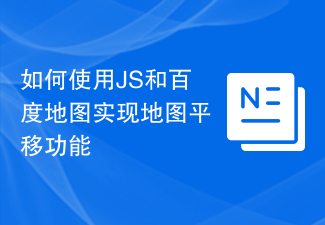 如何使用JS和百度地图实现地图平移功能Nov 21, 2023 am 10:00 AM
如何使用JS和百度地图实现地图平移功能Nov 21, 2023 am 10:00 AM如何使用JS和百度地图实现地图平移功能百度地图是一款广泛使用的地图服务平台,在Web开发中经常用于展示地理信息、定位等功能。本文将介绍如何使用JS和百度地图API实现地图平移功能,并提供具体的代码示例。一、准备工作使用百度地图API前,首先需要在百度地图开放平台(http://lbsyun.baidu.com/)上申请一个开发者账号,并创建一个应用。创建完成
 js字符串转数组Aug 03, 2023 pm 01:34 PM
js字符串转数组Aug 03, 2023 pm 01:34 PMjs字符串转数组的方法:1、使用“split()”方法,可以根据指定的分隔符将字符串分割成数组元素;2、使用“Array.from()”方法,可以将可迭代对象或类数组对象转换成真正的数组;3、使用for循环遍历,将每个字符依次添加到数组中;4、使用“Array.split()”方法,通过调用“Array.prototype.forEach()”将一个字符串拆分成数组的快捷方式。
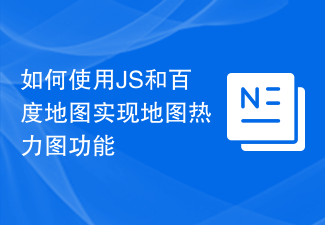 如何使用JS和百度地图实现地图热力图功能Nov 21, 2023 am 09:33 AM
如何使用JS和百度地图实现地图热力图功能Nov 21, 2023 am 09:33 AM如何使用JS和百度地图实现地图热力图功能简介:随着互联网和移动设备的迅速发展,地图成为了一种普遍的应用场景。而热力图作为一种可视化的展示方式,能够帮助我们更直观地了解数据的分布情况。本文将介绍如何使用JS和百度地图API来实现地图热力图的功能,并提供具体的代码示例。准备工作:在开始之前,你需要准备以下事项:一个百度开发者账号,并创建一个应用,获取到相应的AP
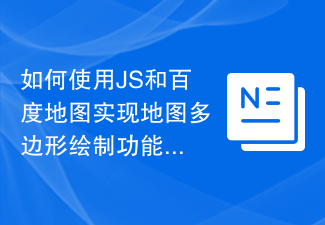 如何使用JS和百度地图实现地图多边形绘制功能Nov 21, 2023 am 10:53 AM
如何使用JS和百度地图实现地图多边形绘制功能Nov 21, 2023 am 10:53 AM如何使用JS和百度地图实现地图多边形绘制功能在现代网页开发中,地图应用已经成为常见的功能之一。而地图上绘制多边形,可以帮助我们将特定区域进行标记,方便用户进行查看和分析。本文将介绍如何使用JS和百度地图API实现地图多边形绘制功能,并提供具体的代码示例。首先,我们需要引入百度地图API。可以利用以下代码在HTML文件中导入百度地图API的JavaScript
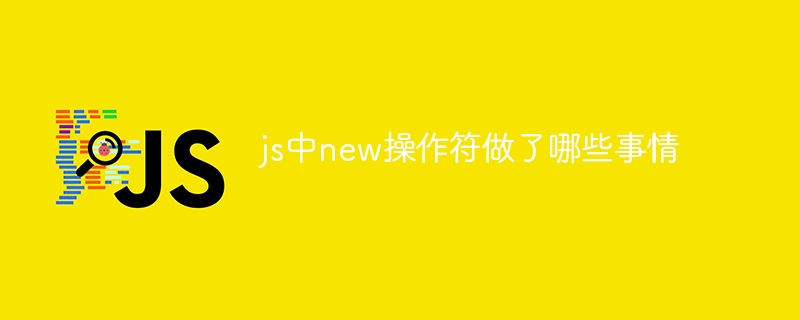 js中new操作符做了哪些事情Nov 13, 2023 pm 04:05 PM
js中new操作符做了哪些事情Nov 13, 2023 pm 04:05 PMjs中new操作符做了:1、创建一个空对象,这个新对象将成为函数的实例;2、将新对象的原型链接到构造函数的原型对象,这样新对象就可以访问构造函数原型对象中定义的属性和方法;3、将构造函数的作用域赋给新对象,这样新对象就可以通过this关键字来引用构造函数中的属性和方法;4、执行构造函数中的代码,构造函数中的代码将用于初始化新对象的属性和方法;5、如果构造函数中没有返回等等。
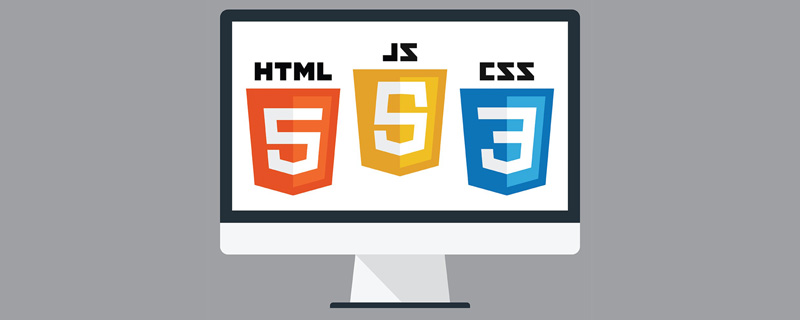 用JavaScript模拟实现打字小游戏!Aug 07, 2022 am 10:34 AM
用JavaScript模拟实现打字小游戏!Aug 07, 2022 am 10:34 AM这篇文章主要为大家详细介绍了js实现打字小游戏,文中示例代码介绍的非常详细,具有一定的参考价值,感兴趣的小伙伴们可以参考一下。
 php可以读js内部的数组吗Jul 12, 2023 pm 03:41 PM
php可以读js内部的数组吗Jul 12, 2023 pm 03:41 PMphp在特定情况下可以读js内部的数组。其方法是:1、在JavaScript中,创建一个包含需要传递给PHP的数组的变量;2、使用Ajax技术将该数组发送给PHP脚本。可以使用原生的JavaScript代码或者使用基于Ajax的JavaScript库如jQuery等;3、在PHP脚本中,接收传递过来的数组数据,并进行相应的处理即可。
 js是什么编程语言?May 05, 2019 am 10:22 AM
js是什么编程语言?May 05, 2019 am 10:22 AMjs全称JavaScript,是一种具有函数优先的轻量级,直译式、解释型或即时编译型的高级编程语言,是一种属于网络的高级脚本语言;JavaScript基于原型编程、多范式的动态脚本语言,并且支持面向对象、命令式和声明式,如函数式编程。


Hot AI Tools

Undresser.AI Undress
AI-powered app for creating realistic nude photos

AI Clothes Remover
Online AI tool for removing clothes from photos.

Undress AI Tool
Undress images for free

Clothoff.io
AI clothes remover

AI Hentai Generator
Generate AI Hentai for free.

Hot Article

Hot Tools

Safe Exam Browser
Safe Exam Browser is a secure browser environment for taking online exams securely. This software turns any computer into a secure workstation. It controls access to any utility and prevents students from using unauthorized resources.

Notepad++7.3.1
Easy-to-use and free code editor

MantisBT
Mantis is an easy-to-deploy web-based defect tracking tool designed to aid in product defect tracking. It requires PHP, MySQL and a web server. Check out our demo and hosting services.

Dreamweaver CS6
Visual web development tools

ZendStudio 13.5.1 Mac
Powerful PHP integrated development environment





